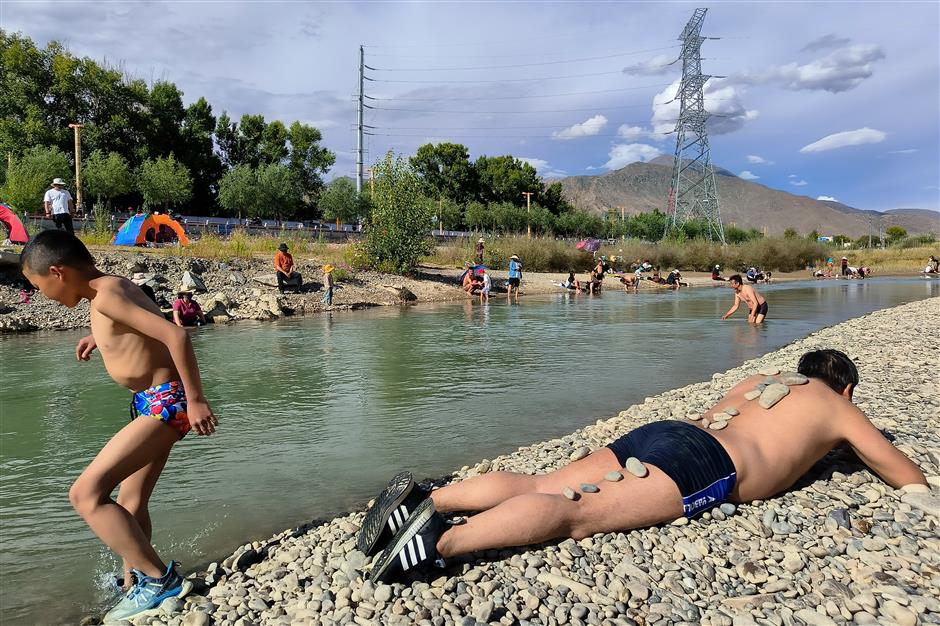Tibetan medicinal bathing: a connection between humans and nature
Editor's note:
The United Nations has officially designated 44 Chinese traditions as world cultural heritage. This series examines how each of them defines what it means to be Chinese.

In Tibetan tradition, bathing is more than just a cleansing ritual; it is a deep connection between humans and nature.
In Tibetan tradition, bathing is more than just a cleansing ritual; it is a deep connection between humans and nature, a practice that harmonizes body and mind.
Every year during the seventh month of the Tibetan calendar, local families gather by rivers and streams to celebrate the Bathing Festival. The Tibetan medicinal bathing, or Lum medicinal bathing of Sowa Rigpa (Tibetan medicine), is a fundamental part of this bathing culture.
In Tibetan, "Lum" refers to the traditional knowledge and practices of bathing in natural hot springs, herbal water or steam to maintain health and treat illness. This practice was inscribed in UNESCO's Representative List of the Intangible Cultural Heritage of Humanity in November 2018.
Legend has it that in the 7th century, Princess Wencheng, daughter of Emperor Taizong of the Tang Dynasty (AD 618-907), struggled to adapt to Xizang's harsh climate after marrying King Songtsen Gampo as part of a marital alliance in AD 641. Their union played a significant role in strengthening ties between Xizang and the Tang Dynasty.
To help the princess, King Songtsen Gampo sought the guidance of a lama, who prepared a medicinal bath for Princess Wencheng. Within weeks, she was cured.
Around 70 years later, another Tang princess Jincheng, who married Tibetan King Tride Tsukten, also used this medicinal bath for health and wellness, highlighting its enduring legacy.
The earliest references to Tibetan medicinal bathing can be found in the "Four Medical Tantras," written in the late 8th century. This practice has since evolved within the Tibetan understanding of life based on Jungwa-nga (five elements: earth, water, fire, wind and space) and a view of health and illness based on Nyepa-sum (three dynamics: Lung, Tripa and Pekan). According to Tibetan medicine, Nyepa-sum are both the essential elements that sustain life activities and the underlying factors that give rise to illnesses.
The tradition is widely practiced in China's Xizang as well as Qinghai, Sichuan, Gansu and Yunnan provinces, with the Yarlung Valley on the Qinghai-Tibet Plateau and the Tibetan farming and pastoral areas as its concentrated inheritance areas.

A Tibetan physician diagnoses a patient through pulse palpation.
Tibetan medicinal bathing is practiced in two ways.
One involves bathing in five types of hot springs containing different minerals.
The other involves bathing with five medicinal ingredients: juniper, ephedra, sandbar willow, rhododendron and Artemisia sieversiana. These ingredients are locally sourced and processed through traditional methods.
The baths are believed to promote blood circulation, reduce inflammation and alleviate conditions such as rheumatism, arthritis and skin diseases.
The practice involves collaboration between Manpa (Tibetan doctors), Lum Jorkhan (pharmacists) and Manyok (bath assistants). Doctors diagnose patients through observation, questions and pulse palpation, tailoring the baths to individual needs.

All the ingredients for Tibetan bathing are locally sourced.

The ingredients are processed through traditional methods.
Bathing Festival: a celebration of happiness and harmony
In the rich tapestry of Tibetan traditions, the Bathing Festival, known in Tibetan as Gamariji, stands out as a cherished event. Taking place from the sixth to the 12th day of the seventh month in the Tibetan calendar, the festival is a time when people from all walks of life gather by rivers, embracing the spirit of togetherness.
During the weeklong celebration, families from cities, villages and nomadic regions come together to bathe in the rivers and wash all their bedding.

Taking place from the sixth to the 12th day of the seventh month in the Tibetan calendar, the Bathing Festival is a time when people from all walks of life gather by rivers.
According to legend, the festival's origins date back centuries to the time of Yuthok Yonden Gonpo, a revered physician known as the "King of Medicine." He was invited by King Trisong Detsen to serve as the royal physician. Despite his duties at the palace, Yuthok remained dedicated to helping the common folks, often traveling to treat the sick while gathering herbs.
One year, a plague swept across the grasslands, leaving many nomads bedridden. Yuthok tirelessly treated the afflicted, saving countless lives, and therefore became known as the "King of Medicine." However, after his passing, an even deadlier plague struck.
Desperate for a cure, the nomads prayed for divine intervention. One night, a gravely ill woman dreamed of Yuthok, who instructed her to bathe in the Lhasa River when a bright star appeared in the southeastern sky. She followed his advice and was miraculously healed.
Word of her recovery spread and soon the sick began gathering at the river to bathe.
Each person who entered the water was cured, leading to the belief that Yuthok had transformed into the bright star to guide his people. For seven days, he used his divine powers to turn the river water into a healing elixir.
Since then, the Bathing Festival has been celebrated annually, with nomads from all over coming to bathe in the rivers for health and happiness.
Today, the Bathing Festival is a joyous occasion. Families bring barley wine, butter tea, tsampa (roasted barley flour) and other festive foods to the rivers. After bathing, they share meals, exchange stories and enjoy each other's company – continuing a tradition that blends culture, health and the deep connection between humans and nature.
 ?
?









